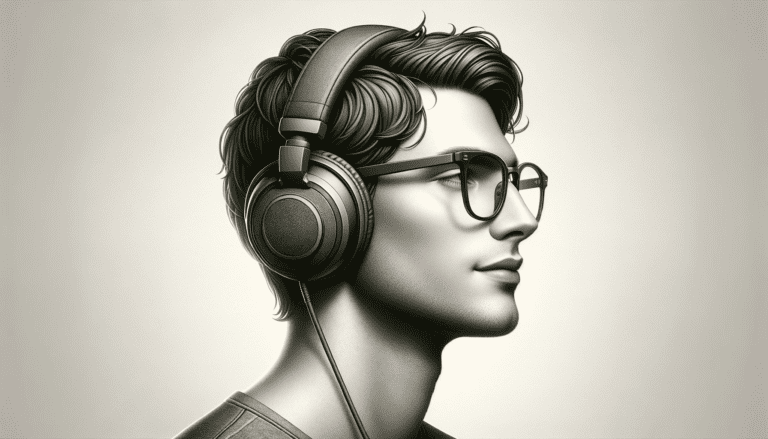If you’re a glasses-wearer, you’ve likely experienced the discomfort — even pain — that can accompany long sessions of wearing headphones. Combining these two essential pieces of gear can indeed pose a challenge. But don’t worry, we’re here to help.
This article is designed to provide an informative guide on how to seamlessly integrate your glasses-wearing experience with your love for top-notch audio. From making strategic choices about your gear to practical tips and tricks, we’ll show you how to enjoy the perfect blend of sound quality and comfort.
Understanding the Challenge: Wearing Headphones with Glasses
For many glasses-wearers, headphones present a daily conundrum. The struggle is real, and generally involves a compromise between crystal-clear vision and quality sound. It’s even more challenging if your day involves extended periods wearing both simultaneously – maybe you’re a gamer, an audio professional, or you work from home and require inputs from both. The discomfort can seem insurmountable, but don’t worry, we’ve got your back.
When glasses and headphones team up, they often exert pressure on the sides of your head, right where the arms of your glasses meet your ears. This added pressure not only can lead to headaches and discomfort, it can also push your glasses out of proper alignment, blurring your vision. The level of discomfort can range from a niggling irritant to downright painful, and… let’s be honest, nobody needs that.
So, how does one navigate this crossroads of modern life? Well, friend, that’s where this guide steps in. We’re going to walk you through a series of steps, hacks, and expert tips to help make your headphones and glasses form a seamless, and comfortable, part of your daily routine.
Whether you’re a die-hard audiophile, or someone who simply likes to listen to the newest pop hits while you work, these tips are designed to help ease discomfort and enhance your experience, enabling you to audibly explore wondrous worlds, or just chill out to some cool tunes, all while maintaining rock-solid focus and perfect clarity of vision.
So whip out those specs, pop on your favorite pair of cans, and join us for a journey through the intricacies of wearing headphones with glasses. You may read also Can You Drive with Headphones
Choosing the Right Headphones: Over-Ear vs On-Ear
When it comes to headphones with glasses, what fits like a dream for one person might be a nightmare for another. That’s why there is no one-size-fits-all answer to this issue. That said, it may help to explore the big players in headphone choices: over-ear and on-ear headphones.
Over-Ear Headphones:
Over-ear headphones are designed to surround or ‘cup’ your ear, thereby providing an immersive listening experience. Because they don’t put direct pressure on your ears, they’re often seen as the prime option for those wearing glasses. But remember, not all over-ear headphones are equal when it comes to comfort. Look specifically for those with larger ear cups and a well-padded, adjustable headband.
On-Ear Headphones:
On-ear, or ‘supra-aural’ headphones, on the other hand, sit on top of your ears. They tend to be smaller, lighter and more portable than their over-ear counterparts. However, because they press on the ears, they could potentially exert unwanted pressure on the temples of your glasses, leading to discomfort over time. That said, some people find them more comfortable due to their lighter weight. The key here is to find a set with a well-cushioned ear cup that mitigates this pressure.
| Headphone Type | Pros | Cons |
|---|---|---|
| Over-Ear | Immense sound quality, comfortable for long periods, larger ear cups. | Heavy weight, less portable, cause ears to heat up over prolonged use. |
| On-Ear | Lighter and more portable, less heating, good for warm climates. | Lower sound quality, pressure on the ears and temple, potential discomfort for glasses users. |
At the end of the day, it’s about finding what works best for you. Both designs have their merits and downsides, so consider these factors and your personal preferences before making a decision. And remember – comfort is key, but sound quality should also be a top priority. Happy listening!
Selecting Glasses with Comfortable Temples for Headphone Use
Seeking comfort when you’re a glasses wearer doesn’t just stop at the headphones. An important aspect to consider when trying to achieve a comfy fit between headphones and glasses, deals with the glasses themselves. More precisely, the temple pieces, also known as the arms of your glasses.
The temple pieces are the parts of your glasses that extend back to your ears. They are key to maintaining the fit and balance of your glasses on your face. If they’re too thick or too rigid, they can cause discomfort when squeezed under headphones, leading to pain and possibly headaches.
So, what’s the solution?
When choosing glasses if you’re regularly going to be wearing headphones, opt for pairs with thin, flexible temples.
- Thin temples reduce the pressure on your head when wearing headphones. They have less surface area to be crushed against your skull by the headphone cushions, making them more comfortable for extended use.
- Flexible temples conform to the shape of your head better, causing less pressure points. They also allow some wiggle room for adjustments while wearing headphones.
In addition, you can consider glasses with padding on their temples. Padded temples as compared to bare metal or hard plastic, soften the blow of the headphones and distribute pressure more evenly.
Another strategy is to go for eyewear brands that are known to concentrate on comfort in their designs. Taking the time to research and invest in such a brand can pay off greatly in the long-term comfort for your ears.
Finally, remember good fit is key. Just as with headphones, glasses should be snug, but not squeeze your head. Tempting as it might be to buy glasses online, it’s advisable to try them on in person before purchasing to make sure they’re comfortable, especially if you intend to wear them with headphones a lot.
Comfortable temples are one piece of the puzzle. The next major factor that you need to consider is how adjustable your headphones are, and we’ll cover that in the upcoming section. You may read the ultimate guide on Can I Use Non-Gaming Headphones for Gaming
The Importance of Adjustable Headbands in Headphones
The major factor to consider when wearing glasses with headphones is the accessibility and versatility of headphone’s headbands. If the headband is not adjustable, the headphones may exert excessive pressure on the glasses’ temples, causing discomfort. That’s why adjustable headbands on headphones may seem like a small, insignificant feature, but trust us, they can make all the difference.
Adjustable headbands essentially give you the power to control how tightly or loosely the headphones fit around your head. This, in turn, can affect the amount of pressure that the headphones exert on your glasses. If you’re wearing glasses and find that your headphones are causing discomfort around the temples of your glasses, simply loosen the adjustable headband to attain a more comfortable fit.
Note: It’s important to find a balance. If the headband is too loose, the headphones may not sit securely on your ears, which can affect sound quality. If it’s too tight, it can squeeze the temples of your glasses against your head, leading to discomfort and even headaches.
Now, you may wonder how exactly to adjust the headband for that ‘perfect’ comfort fit. Well, every headphone brand and model offers a different way to adjust the headband. In general, you’d want to follow these steps:
- Place the headphones over your ears along with your glasses.
- Feel the pressure points around your ears and the temples of your glasses.
- Carefully adjust the headphone band either tighter or looser as needed.
The key is to experiment until you find that sweet spot where the headphones fit securely around your ears without causing discomfort to your glasses. Keep in mind, every person has a different comfort level when it comes to headphone fitment, so your ‘perfect’ fit may be a bit of a trial-and-error exercise. Don’t give up, though. The comfort and better listening experience will be worth the effort.
Remember, comfort should not compromise the sound quality of your headphones. Achieving the perfect balance between comfort and sound quality is the ultimate goal when wearing headphones with glasses.
Exploring Memory Foam Cushions for a Comfortable Fit
If comfort ranks high on your list of priorities, then headphones with memory foam cushions might just be your ticket to a world of relaxation and uninterrupted listening pleasure, even when pairing them with your glasses.
So what’s the big deal about memory foam? Memory foam is a type of material that is incredibly resilient, and it has the ability to mold to the shape of your ear, providing a custom fit. Imagine sinking into a plush, comfortable cushion that takes the shape of your unique ear contour, taking the pressure off your glasses’ temples. Sounds heavenly, doesn’t it?
This material also has excellent sound isolation properties, which can enhance your audio experience. Not only does it comfortably fit around your ears, but it also provides a seal that blocks external noise, allowing you to immerse yourself in your favorite tunes.
Investing in headphones with memory foam cushions can drastically reduce the discomfort caused by the constant pressure on the temples of your glasses. Here’s how:
- Adaptable shape: Memory foam contours to the unique shape of your ear and the arm of your glasses, instead of pushing against them.
- Pressure relief: The foam distributes pressure evenly across its surface, reducing the force exerted on any single point.
- Tight seal: The memory foam forms a seal around your ear, not only enhancing sound quality but also providing some much-needed relief for your squished glasses.
Remember, though, not all memory foam cushions are created equal. Ensure to look for high-quality, dense memory foams that retain their shape well over time. A reduced quality foam may flatten out quickly, defeating the purpose of your cushiony comfort.
Wearing glasses should not be a barrier to high-quality, comfortable sound. Memory foam cushions can help you happily bridge the gap between visual clarity and auditory delight.
Maintaining Proper Hygiene to Prevent Discomfort
Maintaining good hygiene practices can make a significant difference when you’re trying to combine glasses and headphones in a comfortable way. You might be wondering, “What does hygiene have to do with this?” Allow me to explain.
Clean Glasses:
Over time, your glasses can accumulate dirt, oil, and sweat around the arms and nose bridge. This not only creates discomfort but can also cause your glasses to slip down your nose, requiring frequent readjusting. Therefore, cleaning your glasses regularly matters. You can simply use a soft cloth and eyeglass cleaning solution to keep your glasses clean and in their best condition.
Headphone Care:
Just as your glasses need regular cleaning, so do your headphones. Wipe down the ear cups and headband after each use, especially if you’ve been wearing them for long periods or have been exercising with them on. A cloth dampened with a mild soap solution is usually sufficient for this. Keeping them clean will prevent buildup that can affect their fit and comfort level over time.
Remember, regular maintenance of both your glasses and headphones isn’t just a part of good hygiene, it can also extend the life of your devices and accessories. It’s a win-win!
Now, let’s talk about perfecting the placement of both these essential accessories on your head.
Optimizing Placement: Where Your Glasses and Headphones Should Sit
Proper placement of your glasses and headphones is crucial to achieving a comfortable fit. When not positioned properly, the pressure from the headphones can lead to discomfort primarily on the top of your ears and at the temples.
Step one: The right place for your glasses is where they are naturally intended to sit, comfortably rested on your ears and nose. Putting on your glasses in the correct position first lays the foundation for headphone placement subsequently.
Step two: Next, focus on the placement of your headphones. The headband should rest on your head comfortably, ensuring the weight of the headphones is distributed evenly around your ears, not on the top corners of your glasses.
Remember: If you’re wearing over-ear headphones, the cushion should encompass your ear fully, without pressing your glasses against your head. For on-ear headphones, the pads should sit on the ear, avoiding the spectacle frames where possible.
You may need to do some adjustments to find the ‘sweet spot,’ where both your glasses and headphones can exist together in harmony. Experiment with slight movements until you find the perfect fit. This might require some patience, but the comfort gained will significantly enhance your audio experience.
Every person’s head shape and glasses are different, so there’s no ‘one-size-fits-all’ solution; discovering your ideal, comfortable setting is the key.
If you’re using headphones with a flexible headband, you have the advantage to adjust and mold the fit to your liking. Same way, look for glasses with a flatter and thinner temple, which would provide less interference with the headphones.
Tips and Hacks to Prevent Discomfort When Wearing Glasses and Headphones
Tip 1: Loosen Up
It’s a simple tip, but an effective one. Loosen up your glasses slightly before putting on your headphones. Your glasses don’t have to dig into your temples to stay in place. Try this: gently expand the arms of your glasses for added comfort. Give your glasses enough breathing room, especially where they overlap with your headphones.
Tip 2: Layering Strategy
When it comes to layering your glasses and headphones, there’s a definite strategy that can pay off in comfort. Generally, you should put your glasses on first, allowing them to sit in their natural position above your ears. Then, place your headphones atop. This helps avoid unnecessary pressure on the temples of your glasses.
Tip 3: Intervals
Even the most comfortable combinations of glasses and headphones can start to hurt after prolonged use. To circumvent this, try taking mini breaks – remove your glasses and headphones at regular intervals to give the covered areas some respite. Regular intervals of rest can prevent discomfort from even starting.
Tip 4: Earpad Adjustments
Experimenting with the positioning of the earpads can also make a significant difference in your comfort levels. Some people find relief by slightly offsetting the earpads, so they don’t match up directly with your glasses’ temples. This can often alleviate pressure points and make wearing both more comfortable.
Tip 5: Hydrate Your Skin
Hydration isn’t just for your inside, it’s also crucial for your skin, especially around your ears and temples. A dab of a hydrating cream or lotion around these areas can improve comfort – it prevents friction and can improve the overall fit and feel of your headphones and glasses.
Tip 6: Anticipation and Planning
If you know you’re in for a long session of wearing glasses and headphones, consider pre-emptive measures. A pain-relief patch or heated pad applied on sensitive areas, before you put on your glasses and headphones, can often create a buffer and reduce discomfort.
Softening the Pressure: Pads and Cushions to Improve Comfort
One of the best strategies to enhance comfort when wearing headphones and glasses simultaneously is to soften the areas where most of the pressure is applied — the pads and cushions on your headphones. Think of them as your allies in the battleground of comfort, especially when you don’t have the liberty to compromise on your vision or audio experiences. So let’s dive into how you can make the most of them.
Headphone pads or cushions basically have two primary roles – providing comfort to your ears and creating a seal for better sound quality. Here’s the catch though – not all headphone pads are made the same. They vary greatly in terms of their materials, thickness, and shape. You’ve got everything from plush memory foam pads to sports-style textile pads.
Memory foam pads are well-known for their softness and ability to conform to the shape of your ear, minimizing the pressure on your temples (where your glasses sit). This material adjusts nicely with the thermodynamics of your body, creating a personalized fit over time.
If you’re into sports headphones, you might have come across textile pads. They’re more breathable, reducing ear sweating. They might be less plush than memory foam pads but they’re no less comfortable. Ideally, they should sit comfortably around your ears without pressing too hard on your glasses’ temples.
The thickness and shape of the pads can also make a significant difference. Thicker and rounder pads can grant more space for your glasses. You can even opt for headphones with replaceable ear pads, giving you the freedom to switch between different types based on your comfort and needs.
But, what if your headphones came with uncomfortable cushions? Or what if they’ve worn out over time? Luckily, there’s a fix for that too! You can purchase aftermarket headphone pads to substitute the default cushions. There’s a plethora of options available in the market that cater to different sizes and types of headphones.
Remember, the goal is to reduce the pressure exerted on your temples while ensuring that your headphones still deliver premium audio quality. It’s about balancing comfort with sound — so don’t sacrifice one for the other.
Choosing the right pair of pads or cushions can go a long way in providing you with a pain-free and enjoyable listening experience. But remember, while these changes can result in dramatic improvements, they should be supplemented with the other tips we’ve shared in the preceding sections like proper headphone and glasses selection, placement, and hygiene maintenance.
Balancing Sound Quality and Comfort
Both sound quality and comfort are paramount when you’re choosing the perfect pair of headphones to wear with your glasses. But how do we strike a balance between the two? Let’s dive in to uncover the answer.
You might be theorizing whether the pursuit of top-tier sound quality could potentially compromise your comfort, notably when glasses come into play. Let’s face it – no one wants to sacrifice the pleasure of a rich, immersive sound. Yet, bearing an uncomfortable pair of headphones for the sake of unmatched audio fidelity is not an ideal trade-off. That’s why striking a balance between the two holds the key.
Fidelity vs Comfort – A Necessity, Not a Choice
The first thing to understand is that it’s not about choosing fidelity over comfort or vice versa. What’s needed here is a solution that offers both – an incredible sound experience without the slightest discomfort, even when you’re wearing glasses.
When you think about it, comfy headphones should cater to not just your ears, but to your glasses as well. Your headphones should sit snugly over your ears without pushing your glasses’ temples into your head. To achieve this, you might need to invest in headphones that come with features like adjustable headbands and memory foam ear cushions for that extra layer of comfort.
Element of Personal Preference
Now, the definition of ‘comfort’ can vary greatly from person to person. You might prefer on-ear headphones while someone else might find over-ear variants more comfortable. Hence, personal preference plays a major role in deciding the right pair of headphones for glasses wearers.
Remember, if the fit isn’t right, even the highest audio quality can’t make for an enjoyable listening experience. Your perfect pair of headphones is one that grants the privilege of impeccable sound without straining your ears or troubling your glasses.
So, next time you find yourself wondering how to choose the right headphones that blend both sound quality and comfort, remember that it’s not an either-or situation. It’s about harmonizing the two, paving your way for an unparalleled audio experience while wearing glasses.
Expert Advice: How Audio Professionals Handle Glasses and Headphones
Audio professionals such as DJs, sound engineers, and radio hosts often spend long hours wearing headphones while also sporting glasses. Over time, they have developed some pretty effective strategies to mitigate any discomfort. Let’s delve into their world and tap into their experience to guide us on a comfortable headphones and glasses journey.
Firstly, choice of gear is crucial. Most professionals choose headphones with a larger ear cup size, which can comfortably accommodate their glasses’ temples. They usually recommend headphones with an adjustable headband and memory foam cushions. These features allow for a snug fit without the unnecessary pressure.
Posture matters a lot. Audio professionals stress the importance of correct positioning. Glasses should sit on the nose naturally, while headphones should rest lightly on the head, not pressing downwards but simply cushioning the ears.
The professionals also advocate regular breaks. Giving your ears and the area around your temples regular breathing space can significantly reduce any sensation of discomfort or pain.
Lastly, maintaining cleanliness plays a crucial role. Keeping both the glasses and headphones clean not only ensures good hygiene but also prevents skin irritations.
Personalization is also key. What one person might find most comfortable, another might not. Sound engineers and professionals often have to experiment with different products, adjustments, and techniques to find what works best for them.
“One tool will not fit all solutions. The trick is in understanding your needs, experimenting with different options, and making educated choices to create a comfortable, personalized setup.”
Conclusion
In conclusion, wearing headphones with glasses needn’t be a troubling experience if approached wisely. By choosing the right headphones and glasses, prioritizing comfort, making smart adjustments to your devices, and taking simple yet effective care of your equipment and skin, it’s entirely possible to enjoy both exceptional sound quality and optimal comfort simultaneously. Could there be discomfort?
Potentially. Yet with anticipation and planning, adopting these tips, and understanding your personal preferences, it becomes manageable, and even comfortable. Just take it in stride and keep evolving your strategy. Next time you gear up for a marathon listening session, your glasses won’t be the barrier between you and those beloved tunes!







